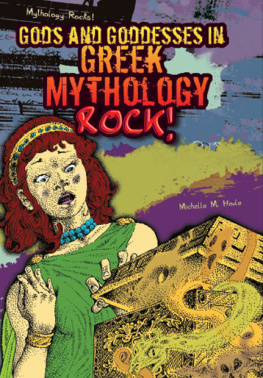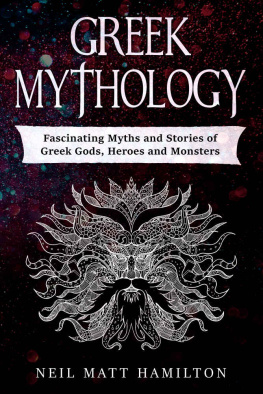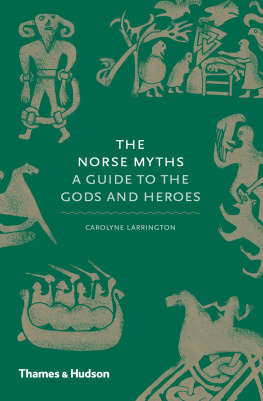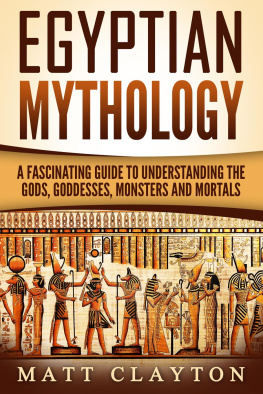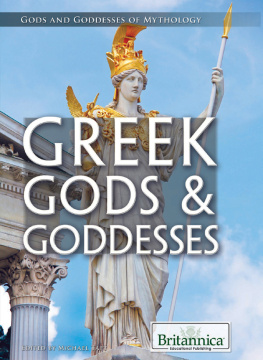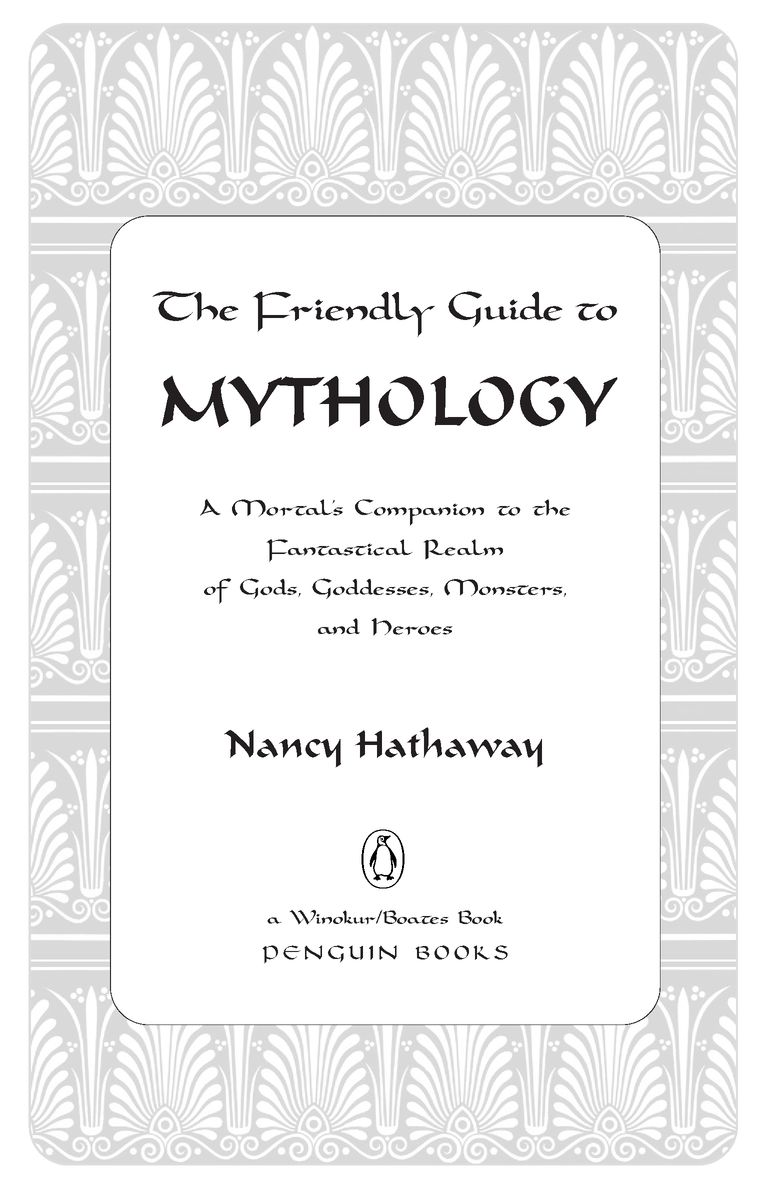Table of Contents
PENGUIN BOOKS
THE FRIENDLY GUIDE TO MYTHOLOGY
Nancy Hathaway is the author of The Unicorn, Native American Portraits: 1862-1918, Giving Sorrow Words (with Candy Lightner), and The Friendly Guide to the Universe. She lives in New York City.
for George
Hail, Muse! et cetera.
Lord Byron
Acknowledgments
The longer a project takes to complete, the harder it is to construct a list of acknowledgments. Ill stick to the highlights. Jennifer Ehmann has been perspicacious and kind: a rare combination, and not only among editors. Production editor Jennifer Kobylarz, designer Nancy Resnick, and assistant production manager Grace Veras also merit praise, as does picture researcher Gillian Speeth. I am grateful to Rona Berg, Virginia Hooper, Jim Solomon, and everyone at the New York Society Library; to Helen Abbott, Sharon Bronte, and Diana Rico; and to Margo Kaufman, whose observations about writing (and everything else) never failed to make me laugh. Most of all, I want to thank Reid Boates and Jon Winokur, who have been supportive, entertaining, and helpful from beginning to end; my mother, Hannah Berman, who provided the drawings on pages 19, 66, 86, 91, 95, 103, 120, 162, 212, 217, 223, and 295; and my husband, George Sussman, who sustained me in every way.
Preface
When I started to work on this book, I found myself identifying not with Edith Hamilton or Jane Harrison or any of the other mythologists who inspired me to undertake the project, but rather, to my own dismay, with the juiceless Mr. Casaubon of Middlemarch, who in his culminating age (around forty-eight) marries the high-spirited and high-minded Dorothea Brooke and then does his best to subjugate her. One of his chief weapons in this endeavor is his book, A Key to All Mythologies, a never-ending labor of research that causes even courtship to feel like a burden to him. I feed too much on the inward sources, he admits. I live too much with the dead. As if to prove the point, he spends their Roman honeymoon in a library. His immersion in his subject, his ever-increasing collection of notebooks, and (no doubt) his advanced age turn his mind into a sort of dried preparation, a lifeless embalmment of knowledge. It is easy to mock Mr. Casaubon, and to everyones relief, he dies early on, his book unfinished... indeed, unbegun.

Dagon
Reading Middlemarch, I felt deeply sympathetic to him. True, he is a sour, unlikable man, and when he talks about his new view of the Philistine god Dagon and other fish-deities, even the noble Dorothea can muster up nothing better than fervid patience. Though he seems pathetic, mean, and badly out of touch, I prefer to think that he is so enticed by the mystifying realm he finds in books that he just cant focus on the day-to-day reality of human beings and cottages.
After all, give him his due: the world of mythology found within the library walls is neither mundane nor arid. It is verdant, crawling, lush, an overgrown garden abuzz with life, and everywhere one wanders within in it, whether among the ancient Greeks or the Aztecs, the Egyptians or the Eskimos, one discovers the bizarre and the familiar, the gorgeous and the grotesque, the marvelous, the unsettling, and the raucously funny, all jumbled together. My theory is that Mr. Casaubon is one of those Victorians with a bacchanalian hidden life. He indulges himself at the library.
In contrast to Mr. Casaubons unwritten tome, The Friendly Guide to Mythology does not attempt to dissect every mythology or to view mythology in one particular way. Unlike Mr. Casaubon, I do not believe that all mythologies are corruptions of a single tradition. I see mythology as an endless, Escher-like puzzle and an ongoing invention, not a static group of stories told by ancient peoples for purposes about which we can only hypothesize. Mythology is always in flux and the forces that reshape it are legion. Societal shifts stimulate new myths and alter old ones, with fresh interpretations arising to fit changing mores. Many myths disappear, leaving behind only tantalizing fragments that hint at their former complexity. On rare occasions, a forgotten myth returns to human awareness after a long absence, the way Gilgamesh, the bestseller of the ancient world, reappeared in 1853 with the discovery of clay tablets buried for almost two and a half millennia. And once in a while, a compelling mythmaker reanimates, revamps, or actually invents a myth.
Even when a myth is fully established, its details can be surprisingly fluid. Storytellers often clash over names, dates, and places, as well as the specifics of a gods birth, a monsters death, or a mortals love affair. Consider, for example, the fate of Ariadne. After Theseus abandoned her, did she die or did she marry Dionysus? In the underworld, did Achilles wed the beautiful Helen or the murderous Medea? Choose the ending you prefer. Remember, too, that any attempt to bring myths up to date (or to retell them) inevitably distorts, for every individual views a myth through a personal prism and every age is dogged by the voices of censorship, taste, or political correctness, call it what you will. When Thomas Bulfinch, employed for thirty years by the Merchants Bank of Boston, completed his Age of Fable in 1855, he did not forget to eliminate from that volume such stories and parts of stories as are offensive to pure taste and good morals. Nathaniel Hawthorne, though admittedly writing for children, acted similarly. In Tanglewood Tales, he justified his omission of disturbing episodes (such as the desertion of Ariadne) by calling them a parasitical growth, having no essential connection with the original fable. In our own day too, every account is just a version. Like an iridescent bird whose color seems to change when either the bird or the observer moves, mythology looks different with each new theory, translation, archaeological find, and sociological shift; and the more standard a myth is, the more likely it is to exist in numerous, often contradictory, forms, each of which is amenable to interpretation. Homer disagrees with Hesiod; Ovid contradicts Pindar; a painted vase or a carved relief illustrates an incident alluded to nowhere else. Mythology is never written in stone, even when it is.
Similarly, mythological characters, human and divine, dont stay put. In the world of mythology, time is elastic and characters often wander from one story to another, making cameo appearances and intruding in surprising ways. Greek mythology in particular is a tightly woven web. Its as if all the characters in Shakespeares plays were somehow related, as if Juliet turned out to be the younger sister of Lady Macbeth, who was friendly with one of the Lear girls, whose mother disappeared under peculiar circumstances involving Falstaff and was turned into a tree in the forest of Arden. In mythology, characters are interrelated, and major figures enter many tales, like players in a never-ending soap opera.
Mythological characters also evolve in interesting ways. Their personalities and positions mutate with history. For instance, in pre-Hellenic Greece, Hera was beloved. Ruling alone as an incarnation of the Great Goddess, she was the numinous center of an important and widespread religious cult (that word having none of the negative implications attached to it nowadays). By the thirteenth century BCE, her power was waning. She was linked with Zeus, philandering thunder god of the Indo-Europeans, and as her reputation devolved, she came to be known primarily as the goddess of marriage and the irritatingly jealous spouse of a randy god. Many mythologists have observed that the marriage of Hera and Zeus was quarrelsome because it was forced; the turbulence reflected the historical conquest of an indigenous goddess-worshipping society by patriarchal invaders. Nonetheless, as Homer suggests in a touching scene in the



